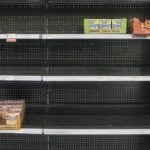 Food shortages were one of the dominant features of the early weeks of the Covid pandemic as people rushed to stores in order to ensure that they had sufficient supplies for lockdown and any periods of enforced isolation.
Food shortages were one of the dominant features of the early weeks of the Covid pandemic as people rushed to stores in order to ensure that they had sufficient supplies for lockdown and any periods of enforced isolation.
Research from Ohio State University reveals how this process exacerbated food inequality as poorer residents were less able to afford to shop online in lieu of trips to big-box stores in the same way that wealthier residents were able to.
With fewer options available to them, poorer people had to double down on the regular trips to local convenience stores and dollar shops in order to get food for their families.
Shopping habits
The researchers analyzed traffic to grocery stores in Columbus, Ohio, during and after the Covid lockdown measures. They found that the small convenience stores in low-income neighborhoods didn’t see any real decline in customers during lockdown, unlike the larger big-box stores.
“Most low-income people still had to shop for groceries in person during the COVID lockdowns and may not have had the economic ability to stock up on food,” the researchers say. “They took fewer trips to mid- and high-end grocery stores outside their neighborhood and continued to go regularly to the stores that were nearest to them, which were the dollar stores and local grocers.”
As with so much during the pandemic, the food problems faced by people of low income were certainly not new, but they were exacerbated by a pandemic that made unequal access to food so stark.
Tracking movement
The researchers used anonymized and aggregated mobile phone data to track travel patterns of nearly 400 grocery stores from across Columbus. Traffic was monitored both before the lockdown, during the lockdown, and then again after the lockdown ended.
The results clearly show that there was a considerable drop in traffic to mid- and high-end stores during the lockdown, with the researchers suggesting this was because their more affluent clientele chose to shop online and stock up on supplies, which meant they didn’t need to visit stores as often.
Smaller convenience stores, however, which are typically situated in low-income neighborhoods, saw a marginal fall in their footfall during the lockdown.
As we might expect, when lockdown measures ended, the traffic to larger stores recovered quickly, albeit with most of that returning traffic visiting from local neighborhoods. There wasn’t a return in traffic from further afield, which includes the poorer neighborhoods.
“We believe the transportation options for people in low-income neighborhoods were limited,” the researchers explain. “Public transit was still less regular, and some may not have been able to combine work and shopping trips as they once did.”
Exposed inequalities
The pandemic exposed the faultlines and inequalities that exist across society, and none were starker than the ability to access food easily and affordably.
“The rich and poor were mostly shopping at different food stores before COVID-19, and those differences became even more stark when the lockdown came,” the researchers say.
The researchers believe that their findings clearly demonstrate the need to provide better food options to people living in low-income areas so that they’re not so reliant on convenience and dollar stores.
“Dollar stores mostly offer packaged and highly processed foods that aren’t healthy,” they conclude. “Policymakers should examine ways to provide better shopping options for people in low-income areas, so they have better access to healthy foods.”